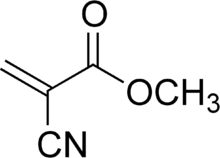Harry Coover

Harry Wesley Coover, Jr. (March 6, 1917 – March 26, 2011)[1] was the inventor of Eastman 910, commonly known as Super Glue.[2]
Life and career
Coover was born in Newark, Delaware, and received his Bachelor of Science from Hobart College before earning his Master of Science and Ph. D. from Cornell University. He worked as a chemist for Eastman Kodak from 1944–1973 and as Vice President of the company from 1973-1984.[1] He later moved to Kingsport, Tennessee,[3] where he spent the rest of his life.
Superglue
In 1942, while searching for materials to make clear plastic gun sights, Coover and his team at Eastman Kodak examined cyanoacrylates, a material that was used during both World Wars as an alternative to stitches on large cuts and wounds, rejecting them as too sticky. Nine years later, Coover was overseeing Kodak chemists investigating heat-resistant polymers for jet canopies when cyanoacrylates were once again tested and proved too sticky. That time around, however, Coover recognized that he had discovered a unique adhesive. In 1958, the adhesive, marketed by Kodak as Super Glue, was introduced for sale.[4]
Generally, cyanoacrylate is an acrylic resin which rapidly polymerises in the presence of water (specifically hydroxide ions), forming long, strong chains, joining the bonded surfaces together. Because the presence of moisture causes the glue to set, exposure to moisture in the air can cause a tube or bottle of glue to become unusable over time. To prevent an opened container of glue from setting before use, it must be stored in an airtight jar or bottle with a package of silica gel. Another convenient way is attaching a hypodermic needle on the opening of glue. After applying, residual glue soon clogs the needle, keeping moisture out. The clog is removed by heating the needle (e.g. by a lighter) before use.
Cyanoacrylate is used as a forensic tool to capture latent fingerprints on non-porous surfaces like glass, plastic, etc.[5] Cyanoacrylate is warmed to produce fumes which react with the invisible fingerprint residues and atmospheric moisture to form a white polymer (polycyanoacrylate) on the fingerprint ridges. The ridges can then be recorded. The developed fingerprints are, on most surfaces (except on white plastic or similar), visible to the naked eye. Invisible or poorly visible prints can be further enhanced by applying a luminescent or non-luminescent stain.

While much attention was given to the glue's capacity to bond solid materials, Coover was also the first to recognize and patent cyanoacrylates as a tissue adhesive. First used in the Vietnam War to temporarily patch the internal organs of injured soldiers until conventional surgery could be performed, tissue adhesives are now used worldwide for a variety of sutureless surgical applications.[4]
Other inventions
Coover held 460 patents and Super Glue was just one of his many discoveries.[4] He viewed "programmed innovation," a management methodology emphasizing research and development, among his most important work. Implemented at Kodak, programmed innovation resulted in the introduction of 320 new products and sales growth from $1.8 billion to $2.5 billion. Coover later formed an international management consulting practice, advising corporate clients around the world on programmed innovation methodology.[6]
Coover received the Southern Chemist Man of the Year Award for his outstanding accomplishments in individual innovation and creativity. He also held the Earle B. Barnes Award for Leadership in Chemical Research Management, the Maurice Holland Award, the IRI Achievement Award,[7] and was a medalist for the Industrial Research Institute.[6] In 2004, Coover was inducted into the National Inventor's Hall of Fame.[2] In 2010, Coover received the National Medal of Technology and Innovation.[8]
Coover died of natural causes at his home in Kingsport, Tennessee, on March 26, 2011.[1]
References
- 1 2 3 Elizabeth A. Harris (March 27, 2011). "Harry Coover, Super Glue's Inventor, Dies at 94". The New York Times. Retrieved March 27, 2011.
- 1 2 "Harry Coover". Hall of Fame. National Inventors Hall of Fame. Retrieved 2010-11-15.
- ↑ "White House to honour Intel researchers". Business Standard. Bloomberg News. October 17, 2010. Archived from the original on 15 November 2010. Retrieved 2010-11-15.
- 1 2 3 "Super Glue". Inventor of the Week. Massachusetts Institute of Technology. September 2004. Retrieved 2010-06-22.
- ↑ Eric W. Brown "The Cyanoacrylate Fuming Method"
- 1 2 "Remarkable Alum: Dr. Harry Coover". Hobart and William Smith Colleges. Archived from the original on May 31, 2010. Retrieved 2010-06-22.
- ↑ "Inventor of the Week: Archive", Lemelson - MIT School of Engineering, September 2004, accessed Feb. 8, 2012.
- ↑ LaJoie, Eliza (26 October 2010). "Alumnus Who Invented Super Glue Wins National Medal of Technology and Innovation". The Cornell Daily Sun. Ithaca, NY. Archived from the original on 15 November 2010. Retrieved 2010-11-15.